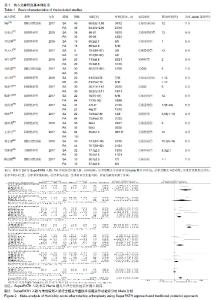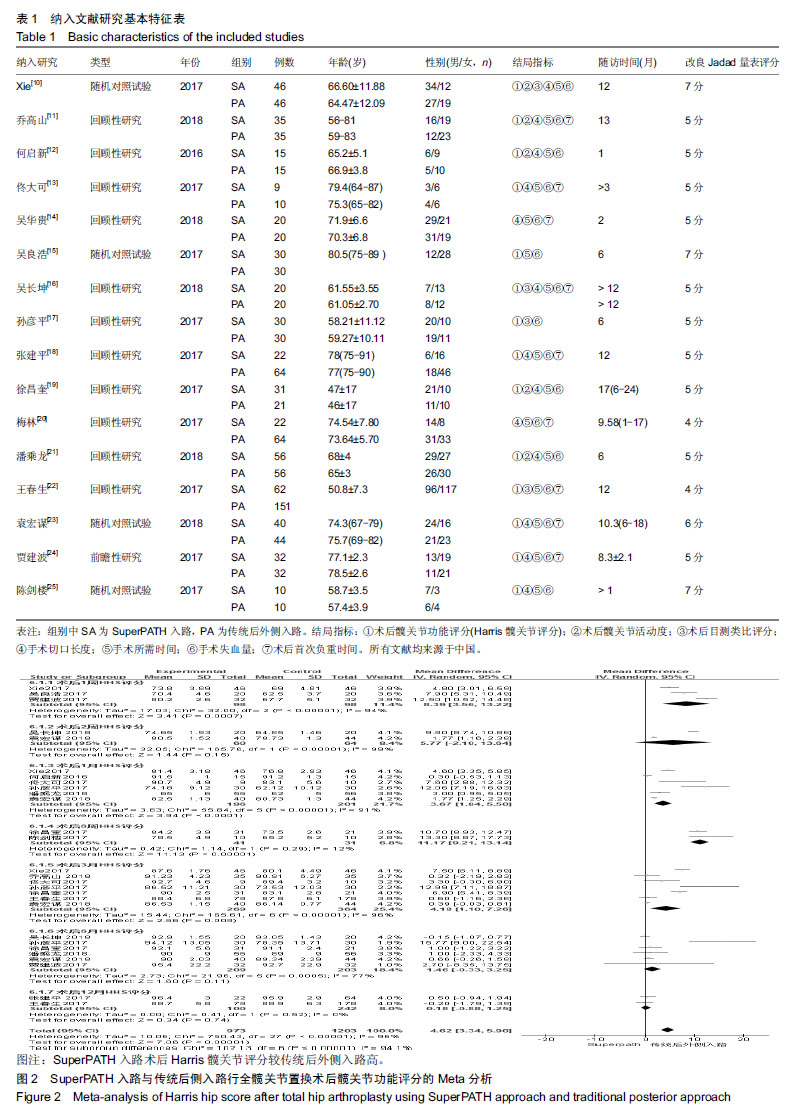Chinese Journal of Tissue Engineering Research ›› 2019, Vol. 23 ›› Issue (24): 3901-3908.doi: 10.3969/j.issn.2095-4344.1300
Previous Articles Next Articles
Clinical outcomes of SuperPATH approach versus traditional posterior approach in total hip arthroplasty: a meta-analysis
- 1Department of Orthopedics, the Second Clinical Medical College of Shanxi Medical University, Taiyuan 030001, Shanxi Province, China; 2Laboratory for Bone and Cartilage Injury Repair of the Second Clinical Medical College of Shanxi Medical University, Taiyuan 030001, Shanxi Province, China
-
Online:2019-08-28Published:2019-08-28 -
Contact:Li Pengcui, MD, Associate chief technician, Laboratory for Bone and Cartilage Injury Repair of the Second Clinical Medical College of Shanxi Medical University, Taiyuan 030001, Shanxi Province, China -
About author:Che Xianda, Department of Orthopedics, the Second Clinical Medical College of Shanxi Medical University, Taiyuan 030001, Shanxi Province, China -
Supported by:the National Natural Science Foundation for the Youth of China, No. 81601949 (to LPC)| the Shanxi Provincial Returned Overseas Students Research Project, No. 2016-118 (to LPC)| the Shanxi Provincial Higher Education Technology Innovation Project, No. 20161119 (to LPC)| the Science and Technology Innovation Foundation of Shanxi Medical University, No. 01201509 (to LPC)
CLC Number:
Cite this article
Che Xianda, Han Pengfei, Gu Xiaodong, Gao Yangyang, Chen Taoyu, Li Pengcui.
share this article
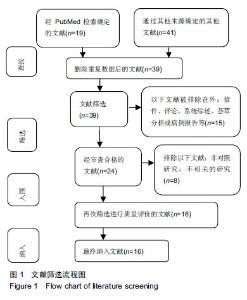
2.1 纳入的研究特征及质量评价 依据上述检索策略,共检索到相关文献60篇。通过阅读文题和摘要,排除重复文献21篇,初筛出39篇相关文献;进一步阅读全文,并严格按照纳入标准和排除标准进行筛查,最终纳入16篇文献[10-25]。各纳入文献研究均比较了患者年龄、病程等基线情况,具有可比性(P > 0.05)。文献筛选流程及结果见图1,纳入文献研究的基本特征见表1。 2.2 Meta分析结果 2.2.1 术后Harris髋关节评分的比较 Harris髋关节评分是由Harris于1969年提出的一套适用于各种髋关节疾病疗效评价的评分,包括疼痛、功能、畸形和关节活动度4个方面,采用标准的百分制评分,是目前国内外最常用的髋关节评分方法。纳入的14篇文献对于SuperPATH入路与传统后外侧入路行全髋关节置换术的术后髋关节功能评分(Harris髋关节评分)做了比较[10-13,15-19,21-25],并根据具体时间不同分了亚组,此结局指标为连续性变量。因为各研究结果间存在异质性(I2 > 50%),故采用随机效应模型进行Meta分析。 结果显示,在行全髋关节置换时,SuperPATH入路术后Harris髋关节评分在术后1周[95%CI(3.56,13.22),P=0.000 7]、1个月[95%CI(1.84,5.50),P < 0.001]、6周[95%CI(9.21,13.14),P < 0.001]、3个月[95%CI(1.10,7.26),P=0.008]等时间点均高于传统后外侧入路,其差异均有显著性意义。其余时间点Harris髋关节评分均相当,其差异均无显著性意义。总的来说SuperPATH入路术后Harris髋关节评分高于传统后外侧入路,其差异有显著性意义[95%CI(3.34,5.90),P < 0.001],见图2。亚组之间异质性较大(I2=96%),考虑是由于各纳入文献随访时间跨度较大导致了亚组之间存在偏倚的潜在风险,因此才进行了亚组分析和敏感性分析。 "
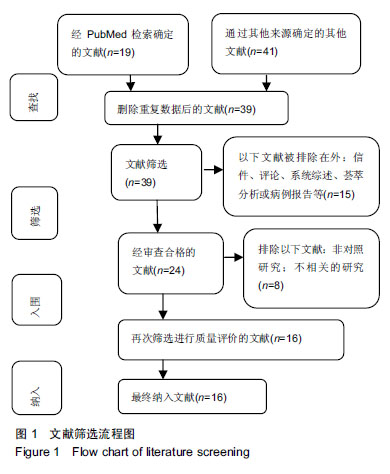
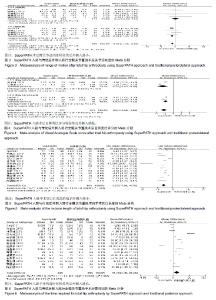
2.2.2 术后髋关节活动度的比较 髋关节活动度的测量目的在于确定术后是否有髋关节活动受限及关节活动受限的程度,对于发现影响关节活动的原因以及判定可能康复的程度提供了理论依据,也是临床医师用来判断手术疗效的常用指标之一。 纳入的5篇文献对于SuperPATH入路与传统后外侧入路行全髋关节置换术后活动度做了比较[10-12,19,21],并根据活动度具体种类分了亚组,此结局指标为连续性变量。因为各研究结果间异质性不大(I2< 50%),故采用固定效应模型进行Meta分析。 结果显示,在行全髋关节置换术时,SuperPATH入路术后髋关节前倾活动度小于传统后外侧入路[95%CI(-1.45,-0.51),P < 0.000 1],两者差异有显著性意义。而外展角活动度相当其差异无显著性意义[95%CI(-1.09,1.52),P=0.75]。总的来说SuperPATH术后髋关节活动度小于传统后外侧入路[95%CI(-1.28,-0.40),P=0.000 2],两者差异有显著性意义,见图3。亚组之间异质性小(I2=0%),考虑是由于各亚组之间数据同质性较好。 2.2.3 术后目测类比评分的比较 目测类比评分在中国临床上广泛用于疼痛的评估。纳入的4篇文献对于SuperPATH入路与传统后侧入路行全髋关节置换术后目测类比评分做了比较[10,16-17,22],并根据具体时间不同分了亚组,此结局指标为连续性变量。因为各研究结果间存在异质性(I2> 50%),故采用随机效应模型进行Meta分析。 结果显示,在行全髋关节置换术时,SuperPATH入路术后目测类比评分在术后24 h[95%CI(-3.83,-1.28),P < 0.001]、7 d[95%CI(-2.33,-1.33),P < 0.001]等时间点均低于传统后外侧入路,其差异均有显著性意义。总的来说SuperPATH入路术后目测类比评分低于传统后外侧入路,其差异有显著性意义[95%CI(-2.99,-1.49),P < 0.001],见图4。亚组之间异质性较大(I2=91%),考虑是由于各纳入文献目测类比评分时间跨度较大导致了亚组之间存在偏移的潜在风险,因此才进行了亚组分析和敏感性分析,结果显示各亚组之间的数据趋向性一致。 2.2.4 手术切口长度的比较 手术切口长度是临床患者关注的重点之一,也是评判手术创伤大小的最常用的指标之一。纳入的13篇文献对于SuperPATH入路与传统后外侧入路行全髋关节置换的手术切口长度进行比较[10-14,16,18-21,23-25],此结局指标为连续性变量。因为各研究结果间存在异质性(I2 > 50%),故采用随机效应模型进行Meta分析。 结果显示,在行全髋关节置换术时,SuperPATH入路手术切口长度小于传统后外侧入路[95%CI(-7.00,-4.70),P < 0.001],其差异有显著性意义,见图5。 2.2.5 手术所需时间的比较 手术所需时间是由众多因素决定的,其中包括手术入路、术中配合以及术者对手术的熟练度等。纳入的15篇文献对于SuperPATH入路与传统后外侧入路行全髋关节置换术手术所需时间做了比较[10-16,18-25],此结局指标为连续性变量。因为各研究结果间存在异质性(I2 > 50%),故采用随机效应模型进行Meta分析。 结果显示,在行全髋关节置换术时,SuperPATH入路手术所需时间长于传统后外侧入路[95%CI(3.30,20.26),P=0.007],其差异有显著性意义,见图6。 "
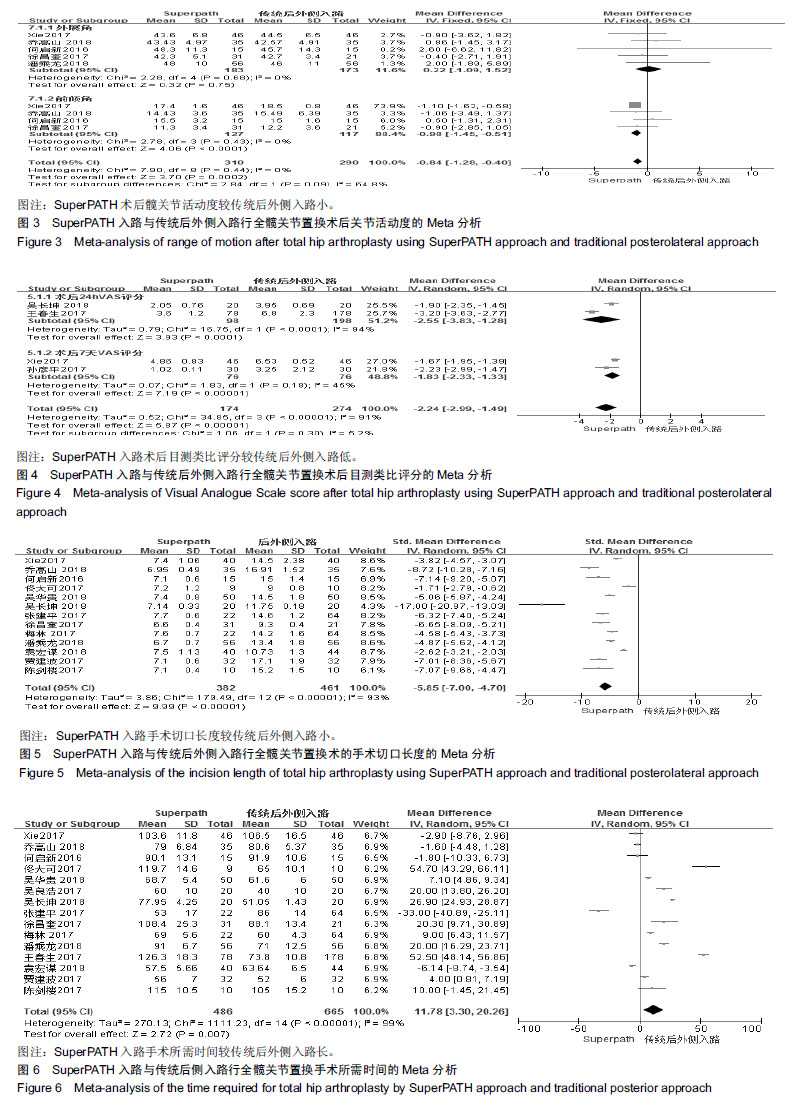
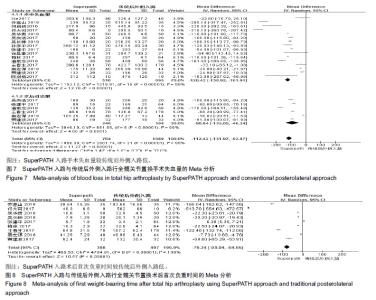
2.2.6 手术失血量的比较 手术失血量是仅次于手术切口长度临床医护用来评价手术疗效的重要指标。纳入的16篇文献对于SuperPATH入路与传统后外侧入路行全髋关节置换术手术失血量做了比较[10-25],并根据术中失血和术后引流分了亚组,此结局指标为连续性变量。因为各研究结果间存在异质性(I2 > 50%),故采用随机效应模型进行Meta分析。 结果显示,在行全髋关节置换术时,SuperPATH入路术中失血[95%CI(-138.92,-101.91),P < 0.001]和术后引流[95%CI(-135.05,-46.24),P < 0.001]均低于传统后外侧入路,其差异有显著性意义。总的来说SuperPATH入路手术失血量低于传统后外侧入路,其差异有显著性意义[95%CI(-131.97,-92.87), P < 0.001],见图7。由于各纳入文献术中和术后2个时间段对于手术入路疗效评价的影响不同,因此才进行了亚组分析,结果显示亚组之间异质性较大(I2=99%),但亚组之间的数据趋向性一致。 2.2.7 术后首次负重时间的比较 术后首次负重时间是患者行全髋关节置换术后行早期康复的重要评价指标。术后首次负重时间越短,患者卧床并发症发生率越低,越有利于术后康复功能锻炼。纳入的9篇文献对于SuperPATH入路与传统后外侧入路行全髋关节置换术后首次负重时间做了比较[11,13-14,16,18,20,22-24],此结局指标为连续性变量。因为各研究结果间存在异质性(I2> 50%),故采用随机效应模型进行Meta分析。 结果显示,在行全髋关节置换术时,SuperPATH入路术后首次负重时间短于传统后外侧入路,其差异有显著性意义[95%CI(-93.94,-64.55),P < 0.001],见图8。"
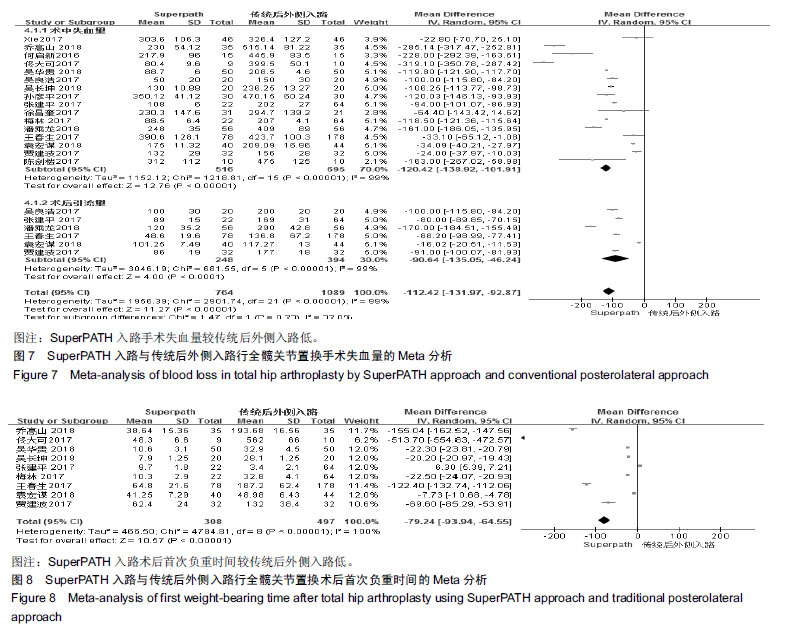
| [1]孙祥燚,张雷,周利武,等.全髋关节置换术治疗成年双侧髋关节发育不良的短期疗效[J].实用骨科杂志,2018,24(8):687-691.[2]王立松,王鹏斌,徐剡,等.全髋关节置换术治疗累及髋关节的强直性脊柱炎临床研究[J].陕西医学杂志,2018,47(4):476-478.[3]卢钰,解京明,张颖,等.全髋关节置换术微创手术入路的应用现状[J].山东医药,2018,58(32):92-94.[4]邓翔天,刘俊才,李忠,等.侧卧位直接前方入路与后外侧入路行全髋关节置换术的疗效分析[J].实用骨科杂志, 2018,24(8): 692-695+700.[5]傅维德,米东,张旭,等.直接前方入路与后外侧入路全髋关节置换术的疗效比较[J].实用骨科杂志,2018,24(2):125-129.[6]Della Torre PK, Fitch DA, Chow JC. Supercapsular percutaneously-assisted total hip arthroplasty: radiographic outcomes and surgical technique. Ann Transl Med. 2015;3(13): 180.[7]Rasuli KJ, Gofton W. Percutaneously assisted total hip (PATH) and Supercapsular percutaneously assisted total hip (SuperPATH) arthroplasty:learning curves and early outcomes. Ann Transl Med. 2015;3(13):179.[8]严卫锋,曾忠友,裴斐.直接前入路与后外侧入路全髋关节置换术的2年随访结果分析[J].中国中医骨伤科杂志, 2017,25(11):59-62.[9]周加平,吉光荣.微创人工全髋关节置换术手术入路研究现状[J].骨科临床与研究杂志,2017,2(3):186-188.[10]Xie J, Zhang H, Wang L, et al. Comparison of supercapsular percutaneously assisted approach total hip versus conventional posterior approach for total hip arthroplasty: a prospective, randomized controlled trial. J Orthop Surg Res. 2017;12(1):138.[11]乔高山,朱乐银,朱成栋,等.SuperPATH入路全髋关节置换术的早期疗效[J].临床骨科杂志,2018,21(1):37-39. [12]何启新,乔巨峰,刘永青.SuperPath微创人工全髋关节置换术与常规全髋关节置换术早期疗效比较[J].广东医学院学报, 2016,34(3): 289-292.[13]佟大可,贺倩芸,刘康,等.SuperPATH入路髋关节置换术治疗股骨颈骨折的短期疗效评价[J].中国骨与关节损伤杂志, 2017,32(3): 308-310.[14]吴华贵.SuperPATH入路与后外侧入路行人工全髋关节置换术的对比观察[J].中国当代医药,2018,25(22):91-93.[15]吴良浩,禹宝庆,陈帆成.SuperPATH微创入路人工股骨头置换治疗老年股骨颈骨折:前瞻性、开放性、随机对照临床试验[J].中国组织工程研究,2017,21(7):1009-1014.[16]吴长坤,姜任东,杨波,等.SuperPATH与后外侧入路全髋关节置换术临床疗效比较[J].中国矫形外科杂志, 2018,26(15):1360-1364.[17]孙彦平,刘月坤,崔晓亮,等.Superpath全髋置换与全髋关节置换术的疗效、疼痛程度及髋关节功能分析[J].中华骨与关节外科杂志, 2017,10(4):305-307.[18]张建平,梁文楷,赵巍,等.Superpath入路与传统后外侧入路髋关节置换疗效对比[J].山西医药杂志,2017,46(22):2726-2728.[19]徐昌奎,蒲小兵,陆遥,等.SuperPath微创后入路全髋置换的早期疗效及应用价值[J].实用医学杂志,2017,33(19):3269-3272.[20]梅林. 微创髋关节置换SuperPATH入路与传统后外侧入路术后早期疗效比较[D].太原:山西医科大学,2017.[21]潘乘龙,何河北,李保林,等.后路微创髋关节置换与后侧髋关节置换术后临床效果比较[J].中华关节外科杂志(电子版), 2018, 12(1):13-17.[22]王春生,蒋武强,马瑞,等.经皮穿刺辅助全髋入路在全髋关节置换的早期应用[J].中华关节外科杂志(电子版), 2017,11(6):565-568.[23]袁宏谋,朱佳俊,孙振国,等.SuperPATH入路与后外侧入路行人工全髋关节置换术的疗效比较[J].中国修复重建外科杂志, 2018, 32(1):14-19.[24]贾建波,禹宝庆,吴良浩,等.传统后路与微创SuperPath入路的半髋置换治疗老年股骨颈骨折疗效比较[J].中华老年骨科与康复电子杂志,2017,3(4):223-231.[25]陈剑楼.SuperPATH技术行全髋关节置换的早期效果分析[J].中国卫生标准管理,2017, 8(17):36-37.[26]黄文文,尹东,黄宇,等.SuperPATH和前外侧小切口入路THA的短期疗效比较[J].实用骨科杂志,2018,24(7):593-596+604.[27]Cronin MD, Gofton W, Erwin L, et al. Early surgical and functional outcomes comparison of the supercapsular percutaneously-assisted total hip and traditional posterior surgical techniques for total hip arthroplasty: protocol for a randomized, controlled study. Ann Transl Med. 2015;3(21):335.[28]关晓龙,袁景,甄平.前外侧和后外侧入路全髋关节置换术的早期疗效比较[J].临床骨科杂志,2018,21(1):43-46.[29]思玉楼,刘娥,杨涛.老年股骨颈骨折双侧同期非骨水泥型与骨水泥型人工全髋关节置换术临床疗效比较[J].医学临床研究, 2018, 35(1):52-55.[30]翟利锋,马苟平.前外侧微创入路对全髋置换手术效果及预后的影响分析[J].浙江创伤外科,2018,23(2):293-295.[31]Yan T, Tian S, Wang Y, et al. Comparison of early effectiveness between SuperPATH approach and Hardinge approach in total hip arthroplasty. Zhongguo Xiu Fu Chong Jian Wai Ke Za Zhi.2017;31(1):17-24.[32]杨天文,孙立,田晓滨.直接前入路初次全髋关节置换术研究进展[J].国际骨科学杂志,2017,38(4):242-246.[33]夏明,李慧,姬宁宁,等.舒芬太尼联合曲马多用于全髋关节置换术后镇痛的研究[J].徐州医学院学报,2016,36(9):572-574.[34]范剑波,姚松柏,周娣,等.后路小切口髋关节置换术在老年股骨颈骨折治疗中的应用研究[J].现代医药卫生, 2017,33(14): 2104-2106.[35]Chow J. SuperPath: The Direct Superior Portal-Assisted Total Hip Approach. JBJS Essent Surg Tech. 2017;7(3):e23.[36]余金素,董斌.围手术期健康教育路径对髋关节置换术患者早期功能锻炼依从性影响[J].安徽医学,2018,39(3):346-348.[37]Bozic KJ, Kamath AF, Ong K, et al. Comparative Epidemiology of Revision Arthroplasty: Failed THA Poses Greater Clinical and Economic Burdens Than Failed TKA. Clin Orthop Relat Res. 2015;473(6):2131-2138.[38]汤琦玫,居红飞.SuperPath入路微创全髋关节置换术围术期护理[J].循证护理,2018,4(7):650-653.[39]Varnum C. Outcomes of different bearings in total hip arthroplasty - implant survival, revision causes, and patient-reported outcome. Dan Med J. 2017;64(3). pii: B5350.[40]Frisch NB, Kadri OM, Tenbrunsel T, et al. Intraoperative chlorhexidine irrigation to prevent infection in total hip and knee arthroplasty. Arthroplast Today. 2017;3(4):294-297. |
| [1] | Wang Jinjun, Deng Zengfa, Liu Kang, He Zhiyong, Yu Xinping, Liang Jianji, Li Chen, Guo Zhouyang. Hemostatic effect and safety of intravenous drip of tranexamic acid combined with topical application of cocktail containing tranexamic acid in total knee arthroplasty [J]. Chinese Journal of Tissue Engineering Research, 2021, 25(9): 1356-1361. |
| [2] | Zhang Chong, Liu Zhiang, Yao Shuaihui, Gao Junsheng, Jiang Yan, Zhang Lu. Safety and effectiveness of topical application of tranexamic acid to reduce drainage of elderly femoral neck fractures after total hip arthroplasty [J]. Chinese Journal of Tissue Engineering Research, 2021, 25(9): 1381-1386. |
| [3] | Chen Jinping, Li Kui, Chen Qian, Guo Haoran, Zhang Yingbo, Wei Peng. Meta-analysis of the efficacy and safety of tranexamic acid in open spinal surgery [J]. Chinese Journal of Tissue Engineering Research, 2021, 25(9): 1458-1464. |
| [4] | Yuan Jun, Yang Jiafu. Hemostatic effect of topical tranexamic acid infiltration in cementless total knee arthroplasty [J]. Chinese Journal of Tissue Engineering Research, 2021, 25(6): 873-877. |
| [5] | Lü Zexiang, Wu Jutai, Jiang Jian, Feng Xiao, Li Tengfei, Wang Yehua. Effect of tranexamic acid combined with carbazochrome sodium sulfonate on blood loss and safety after total knee arthroplasty [J]. Chinese Journal of Tissue Engineering Research, 2021, 25(3): 386-390. |
| [6] | Liu Jianyou, Jia Zhongwei, Niu Jiawei, Cao Xinjie, Zhang Dong, Wei Jie. A new method for measuring the anteversion angle of the femoral neck by constructing the three-dimensional digital model of the femur [J]. Chinese Journal of Tissue Engineering Research, 2021, 25(24): 3779-3783. |
| [7] | Wang Hao, Wang Yitao, Lü Zexiang, Li Tengfei, Wang Shaolong, Wang Yehua. Effect of repeated intravenous tranexamic acid in the perioperative period of proximal femoral nail antirotation for femoral intertrochanteric fracture [J]. Chinese Journal of Tissue Engineering Research, 2021, 25(21): 3319-3323. |
| [8] | Fu Panfeng, Shang Wei, Kang Zhe, Deng Yu, Zhu Shaobo. Efficacy of anterolateral minimally invasive approach versus traditional posterolateral approach in total hip arthroplasty: a meta-analysis [J]. Chinese Journal of Tissue Engineering Research, 2021, 25(21): 3409-3415. |
| [9] | Liu Jinlei, Yin Li, Zhang Yi, Wang Haitao, Li Zhuangyan, Xia Peige, Qiao Renqiu. Effects of intravenous tranexamic acid combined with periarticular multipoint injection of tranexamic acid cocktail on blood loss and pain after total knee arthroplasty [J]. Chinese Journal of Tissue Engineering Research, 2021, 25(18): 2833-2839. |
| [10] | Zhong Yuanming, Fu Xiaopeng, Xu Wei, Zhao Qingrui, Huang Yong, Ye Weiquan. Nicardipine controlled hypotension applied to perioperative blood loss in orthopedics: a meta-analysis [J]. Chinese Journal of Tissue Engineering Research, 2021, 25(18): 2930-2937. |
| [11] | Liu Pengran, Jiao Rui, Tao Jin, Chen Hui, Dai Jihang, Yan Lianqi. Comparison of the effects of total hip arthroplasty with different interface prostheses in the treatment of elderly hip diseases [J]. Chinese Journal of Tissue Engineering Research, 2021, 25(15): 2347-2351. |
| [12] | Gao Zhixiang, Xiao Cong, Yang Hongtao, Meng Xiangyu. Statistical decision tree model analysis on hidden blood loss in the perioperative period of thoracolumbar burst fracture accompanied with neurological deficiency [J]. Chinese Journal of Tissue Engineering Research, 2021, 25(15): 2364-2369. |
| [13] | Li Yonghe, Wang Xiankang, Meng Yu, Liu Lu, Zhang Chunqiu, Ye Jinduo . Mechanical analysis on the position difference of short-stemmed prosthesis in hip arthroplasty [J]. Chinese Journal of Tissue Engineering Research, 2021, 25(15): 2394-2399. |
| [14] | Chen Wang, Feng Shuo, Zhang Yu, Chen Xiangyang. Efficacy and safety of tranexamic acid and epsilon-aminocaproic acid in reducing perioperative blood loss during total knee arthroplasty: a meta-analysis [J]. Chinese Journal of Tissue Engineering Research, 2021, 25(15): 2430-2436. |
| [15] | Gao Fenghe, Chen Tongying, Lin Jiebin, Liang Zujian. Efficacy and safety of tranexamic acid combined with rivaroxaban in primary total knee and hip arthroplasties: a meta-analysis [J]. Chinese Journal of Tissue Engineering Research, 2021, 25(15): 2453-2460. |
| Viewed | ||||||
|
Full text |
|
|||||
|
Abstract |
|
|||||
